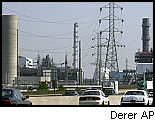From: News and Views | City Beat
|
Monday, February 25, 2002
City's
Been Forced
To Talk
Trash Again
S.I.
landfill shut, but plan collapses
By MICHAEL R. BLOOD
Daily News Staff Writer
 ess than a year after closing
the Fresh Kills landfill, New York City is facing a potential garbage crisis
that could take a long and costly toll on the environment and taxpayers
shouldering the bills. ess than a year after closing
the Fresh Kills landfill, New York City is facing a potential garbage crisis
that could take a long and costly toll on the environment and taxpayers
shouldering the bills.
 |
 |
| Garbage barge (passing
under Brooklyn Bridge) would have been joined by a fleet moving trash to
New Jersey for transfer by rail to landfills. |
For the first time, officials acknowledge that the city's master plan
to rid itself of 24 million pounds of household trash each day has essentially
collapsed.
Proposed truck-to-rail and truck-to-barge projects needed to collect
and export waste have been stopped by everything from neighborhood grumbling
to, in one case, allegations of a sweetheart deal and mob influence.
The elaborate plan "just fell apart," Sanitation Commissioner John Doherty
told the Daily News. "We are basically starting over again.
"Fresh Kills was really closed without an awful lot of thought, you
know, if the story be told," he added. "We are still faced with a big problem."
The unraveling of the plan does not mean New Yorkers will see plastic
bags stacking up on streetcorners, like so many stone walls. Curbside pickups
will continue as always.
Must Rely on Others
What's at issue is where the trash will go, today and years from now;
how it will get there, and what the cost will be to New York's cash-starved
budget and the environment.
With the city's only dump closed, New York is now almost entirely dependent
on others to transport and dispose of its waste beyond its borders. New
Yorkers' trash now ends up in dumps as far away as Virginia and Ohio.
Under the city's timetable, New York was supposed to be well on its
way now to building or contracting for state-of-the-art trash handling
plants that would snugly package refuse for a barge, truck or rail ride
out of town.
It hasn't worked out that way.
Of six proposed projects in the plan five in New York and one in New
Jersey all are delayed, derailed or appear unlikely to succeed.
Next month, the city will select a consultant to spend 18 months working
with the Sanitation Department to recast the 10-year strategy, which will
take years and many millions of dollars to put in place.
 |
 |
| The city's plan
to build a garbage handling facility in Linden, N.J., to process half the
citys household garbage is under investigation on both sides of the Hudson. |
In the meantime, the city is being forced to rely on what was considered
a temporary export plan: hauling garbage to distant landfills and incinerators
one truck at a time, with hundreds of trips rumbling through neighborhoods
each day.
The setbacks come at a steep price.
This year, the Sanitation Department's budget topped $1 billion for
the first time, up from $631 million just five years ago. Almost all of
the new cost is linked to trucking waste out of town following the closing
of Staten Island's Fresh Kills a bill taxpayers absorb.
The city is spending nearly 50% more to export its trash rather than
dump it at Fresh Kills $63 for each ton compared to $43 a ton, according
to the city's Independent Budget Office.
"We're stuck in the worst-case situation: garbage trucks driving hundreds
of thousands of trips a year" in and out of the city, said Benjamin Miller,
a former Sanitation Department policy director who has written a history
of city garbage, "Fat of the Land: Garbage of New York the Last Two Hundred
Years."
"The costs are tremendous: additional fuel, additional truck maintenance,
pollution, congestion, accidents. It's an unacceptable status quo," Miller
said.
With the city facing a fiscal crisis, the department's ballooning budget
"is a concern," Doherty said. The city already plans to cut back recycling
to save $56 million.
Doherty said the budget increase is "directly attributable to the export
cost. It's a big number, but it's the cost of doing business. We don't
have much choice."
It wasn't long ago that the Fresh Kills plan sounded achievable: Close
the mountainous dump (the unhallowed ground where for 50 years the city
buried the dreck and discards of New York households) and ship the trash
by truck, barge and rail somewhere else anywhere else, really.
Troubled Replacement
Staten Island homeowners viewed the 3,000-acre dump, considered the
largest in the country, as a fetid civic lesion and environmental catastrophe.
Gov. Pataki and then-Mayor Rudy Giuliani turned out to commemorate the
day last spring when the final, 650-ton barge of table scraps, wadded Pampers
and burger wrappers entered the landfill.
By the time the dump closed, trucks were hauling the city's household
waste out of town about 12,000 tons a day, much of which was once moved
by barge across New York Bay to Staten Island from other boroughs.
But the long-term plan to establish a network of transfer stations and
packing plants with rail and barge connections the idea the city still
wants to pursue was troubled almost from the start.
"We initially thought we had sites in Brooklyn, in Bay Ridge, in Red
Hook, Carteret [N.J.] different places that we thought would meet our
needs. For various reasons, because they weren't acceptable to communities,
they just didn't fly," said Doherty, who is serving his second stint as
commissioner.
The most controversial part of the plan called for the city to sign
a 20-year contract with Browning Ferris Industries, part of the conglomerate
Allied Waste Industries, to build a garbage handling facility in Linden,
N.J. Within several years, it was projected, the 18-acre site would process
half the city's household garbage.
The proposed contract, expected to cost taxpayers as much as $200 million
a year, called for sending barges of trash from the city to Linden, just
across from Staten Island. There, the waste would be packaged and shipped
by rail to landfills.
The deal is under investigation on both sides of the Hudson, and a contract
has never been signed.
New Jersey Opposed
The plan to ship waste by train from Linden is opposed by New Jersey's
new governor, Jim McGreevey, who told The News that "the trash train would
expose many New Jersey families to unnecessary ... health and safety risks."
A report released by the New Jersey attorney general's office last year
alleged the proposed deal would create a windfall for the company that
would lease the land to Browning Ferris. One of the owners of the company,
Tremley Point Marine Terminal, is Dominick Pucillo, the son-in-law of Linden
Mayor John Gregorio.
The attorney general's report said Gregorio, as mayor, "participated
in matters where his son-in-law had a financial interest" a charge Gregorio
denied.
Another concern for city officials is that another part-owner in Tremley
Point is the wife of New Jersey businessman Benny Villani, who is banned
for life from doing business in the city's waste industry and has been
linked by federal officials to organized crime.
The city considers the Linden deal essentially dead unless it's substantially
changed.
"We in the city ... do not intend to deal with these people," Doherty
said. "We know there is a problem."
Pucillo's lawyer, Gerald Krovatin, said there were errors in the attorney
general's "hastily" prepared report.
"It's a commercially reasonable and sound deal," Krovatin said.
Deborah Gauger, a spokeswoman for Allied Waste, the corporate parent
of Browning Ferris, said contract talks with the city were "ongoing" but
declined to provide specifics about the negotiations or the status of the
New Jersey investigation.
Beginning this year, the Bloomberg administration must rebid more than
15 waste trucker contracts, which are expected to rise in cost, perhaps
sharply, over time.
Another question mark for the city is whether Congress ultimately will
give states or local governments the power to restrict the amount of waste
crossing borders. Lawmakers in states where landfills import large amounts
of trash, such as Pennsylvania, have sought such controls for years.
Doherty, among others, says New York State must begin to look for new
landfill space on home turf.
Not in Their Backyard
New York's export program is a boon for the waste hauling and disposal
industry. But historically, the city's garbage has been viewed skeptically
by communities around the country.
Governors from New Jersey to Virginia have railed about New Yorkers'
garbage being transported through, or dumped in, their states. New York
has been derided for wallowing in a feckless "culture of waste," as former
U.S. House Speaker Newt Gingrich once famously said.
Former New Jersey Gov. Christie Whitman suggested in a news release
that New York "drop dead" after the city proposed sending trash to transfer
stations in New Jersey.
In the city's defense, Giuliani said in 1999 that the rest of the nation
was obligated to take city trash in exchange for the cultural and financial
benefits generated by New York.
The confusion in the city's long-term garbage plan has led to calls
to reopen Fresh Kills, which still has 20 to 30 years of useful life left,
according to some estimates. It's currently being used as a place to ship
and inspect debris from the collapsed World Trade Center buildings.
Miller has said the governor should use his emergency powers to reopen
Fresh Kills as a dump, especially in light of the city's financial problems
following the Sept. 11 terrorist attacks.
"No. No. No. In big letters: No," Doherty said, emphatically shaking
his head. "I live on Staten Island I want to live there a long time.
"The city is going to have to go through this pain," he said. "Fresh
Kills had to close at some point. ... The city had to face it.



What do you think? Post
your comments on our Forums.
|











